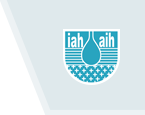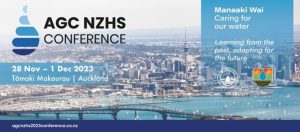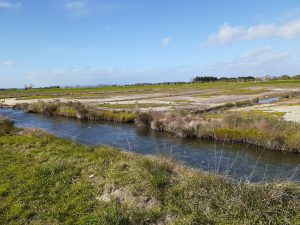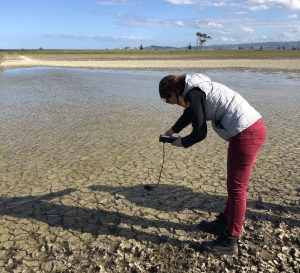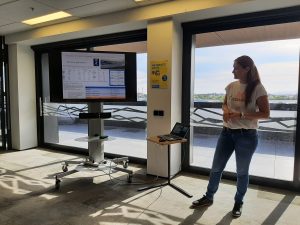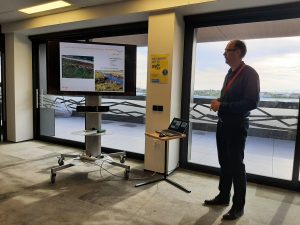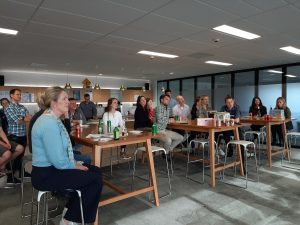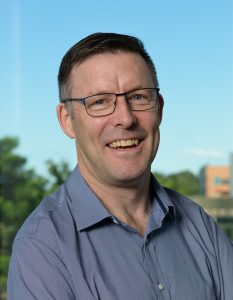2023
AGC NZHS Conference – Australasian Groundwater & New Zealand Hydrological Society Conference – November 2023 – Auckland
The end of the year was seen out by the Australasian Groundwater Conference (AGC) which was hosted together with the New Zealand Hydrological Society in Auckland at Auckland University of Technology (AUT) on 28 November – 1 December 2023.
Over 350 delegates attended from all over New Zealand, Australia and further afield. The conference commenced with a well-attended Groundwater Modelling workshop and ended with a hugely popular, as always, conference dinner followed by two fantastic field trips. Five simultaneous sessions hosted a total of 300+ presentations for three days.
18 October 2023 – Christchurch
Amandine Bosserelle from University of Canterbury and Eric van Nieuwkerk from WSP presented Saltwater Intrusion exacerbated by sea-level rise affecting productive land in New Zealand to a large audience at WSP in Christchurch.
 Eric has more than 20 years’ experience as a Hydrogeologist working in interdisciplinary teams and has been responsible for a wide range of groundwater and environmental science projects including coastal groundwater investigations, saltwater intrusion studies, water take effect assessments, 3D groundwater and solute transport modelling, water quality impact assessments, aquifer testing, water supply well design and contaminant risk assessments. Eric has extensive experience in water resource investigations and civil engineering projects in New Zealand, Australia and the Netherlands, working for a variety of clients.
Eric has more than 20 years’ experience as a Hydrogeologist working in interdisciplinary teams and has been responsible for a wide range of groundwater and environmental science projects including coastal groundwater investigations, saltwater intrusion studies, water take effect assessments, 3D groundwater and solute transport modelling, water quality impact assessments, aquifer testing, water supply well design and contaminant risk assessments. Eric has extensive experience in water resource investigations and civil engineering projects in New Zealand, Australia and the Netherlands, working for a variety of clients.
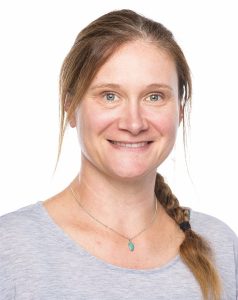 Amandine is a Groundwater Research Scientist and PhD Candidate with experience in groundwater numerical modelling, field investigations and data analysis. She focuses on coastal hydrosystems and climate change impacts on fresh groundwater resources. Since 2006 she has been working in consulting and research studies in New Zealand, Australia and some Pacific Islands.
Amandine is a Groundwater Research Scientist and PhD Candidate with experience in groundwater numerical modelling, field investigations and data analysis. She focuses on coastal hydrosystems and climate change impacts on fresh groundwater resources. Since 2006 she has been working in consulting and research studies in New Zealand, Australia and some Pacific Islands.
Climate change and sea-level rise may impact New Zealand’s productive aquifers but also will affect coastal waters and productive land. Using several case studies in New Zealand, we will explore how saltwater intrusion affects shallow groundwater and coastal farmland in this presentation.
16 August 2023 – Auckland
Dr Jeremy Bennett from Tonkin & Taylor Ltd presented Give it a whirl: Sedimentary anisotropy and its effect on solute mixing to an audience at the T+T Offices in Auckland.
Abstract
When sediments are deposited in stream channels, they retain the ‘‘imprint’’ of the stream flow that deposited them. Groundwater flows more easily along the path of this streamflow imprint than against it—this is called anisotropy. Many groundwater systems are made up of deposits from many different depositional environments and so will have many different imprints, even when the deposits are close to each other. We found that this can cause groundwater to flow along complicated and tangled paths (groundwater “whirls”). These tangled groundwater paths can change the way that contaminants move through the subsurface, particularly at the fringes of contaminant plumes. This, in turn, can enhance reactive and natural attenuation processes, which may have positive implications on remediation activities.
The presentation described how sedimentary anisotropy may occur in the real world, and what its potential impacts are on groundwater flow and solute mixing. Although theoretical in nature, the talk provided some interesting insights into the groundwater whirls beneath our feet.
Dr Jeremy Bennett – Senior Groundwater Scientist – Bio
 Jeremy is a senior groundwater scientist at Tonkin & Taylor Ltd, based in Auckland. He specialises in conceptual and quantitative modelling of groundwater flow and contaminant transport as well as environmental data analysis. Originally from Wellington, Jeremy has over 14 years of professional experience as a consultant and researcher in New Zealand, Australia and Germany. He holds an MSc and Doctorate in Hydrogeology from the University of Tübingen, Germany, and his research has been published in international scientific journals.
Jeremy is a senior groundwater scientist at Tonkin & Taylor Ltd, based in Auckland. He specialises in conceptual and quantitative modelling of groundwater flow and contaminant transport as well as environmental data analysis. Originally from Wellington, Jeremy has over 14 years of professional experience as a consultant and researcher in New Zealand, Australia and Germany. He holds an MSc and Doctorate in Hydrogeology from the University of Tübingen, Germany, and his research has been published in international scientific journals.
24 May 2023 – Christchurch
Professor Grant Hose from Macquarie University, NSW presented Assessing change in groundwater ecosystems….. and why it matters to a large gathering at the GHD offices in Christchurch.
Abstract
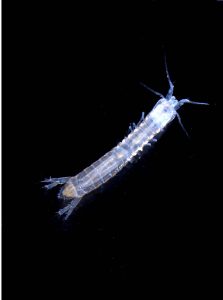 Groundwater and the subterranean ecosystems from which it is drawn are essential for the health and prosperity of environments, societies and cultures yet are threatened by human activities that impact the health and condition of groundwater ecosystems to such an extent that they may no longer provide critical ecosystem services. In this talk I will provide an overview of the structure and function of groundwater ecosystems and what they do for us, how they can be monitored and assessed, and why detecting changes in groundwater organisms and ecosystems matters.
Groundwater and the subterranean ecosystems from which it is drawn are essential for the health and prosperity of environments, societies and cultures yet are threatened by human activities that impact the health and condition of groundwater ecosystems to such an extent that they may no longer provide critical ecosystem services. In this talk I will provide an overview of the structure and function of groundwater ecosystems and what they do for us, how they can be monitored and assessed, and why detecting changes in groundwater organisms and ecosystems matters.
Professor Grant Hose – Associate Dean Innovation – Bio
Grant is Professor in aquatic ecology and ecotoxicology at Macquarie University in Sydney. His research examines the response of groundwater ecosystems, invertebrate (stygofauna) and microbial communities to environmental change, and develops tools for assessing change in ecosystem health and condition. His team has expertise in stygofauna taxonomy and using environmental DNA (eDNA) to characterise the composition and function of groundwater ecosystems. His current research focuses on the impacts of drawdown and contamination on ecosystem function and the roles of stygofauna in providing ecosystem services.
15 February 2023 ECHN Event – Christchurch
The ECHN held its second meeting at Tonkin + Taylor office, PwC Centre, Level 3/60 Cashel Street, Ōtautahi/Christchurch, 8013.
Two talks were presented at this event by Alice Sai Louie PhD candidate at University of Canterbury and Cameron Jasper Senior Hydrogeologist at Tonkin + Taylor.
Presentation 1: “Quantifying losses from braided rivers using active distributed temperature sensing”
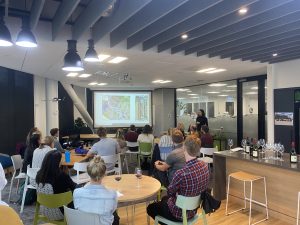 Globally, braided river systems are a major recharge mechanism for alluvial aquifer systems providing a significant contribution to groundwater, yet this process of surface water – groundwater interaction is a gap in hydrological research. River leakage from braided rivers is the main source of groundwater recharge in the Canterbury Plains of New Zealand (Coluccio & Morgan, 2019). This study investigated surface water – groundwater interaction in the Waikirikiri Selwyn River, in the South Island of New Zealand, using Active-Distributed Temperature Sensing (A-DTS) and estimated groundwater recharge to the alluvial aquifer system, as outlined in Banks et al. (2022).
Globally, braided river systems are a major recharge mechanism for alluvial aquifer systems providing a significant contribution to groundwater, yet this process of surface water – groundwater interaction is a gap in hydrological research. River leakage from braided rivers is the main source of groundwater recharge in the Canterbury Plains of New Zealand (Coluccio & Morgan, 2019). This study investigated surface water – groundwater interaction in the Waikirikiri Selwyn River, in the South Island of New Zealand, using Active-Distributed Temperature Sensing (A-DTS) and estimated groundwater recharge to the alluvial aquifer system, as outlined in Banks et al. (2022).
The field study site is within an ephemeral losing reach of the river and contains two active channels. Braided rivers are dynamic, high-energy environments; therefore, the fibre-optic cables were installed beneath the ground to protect this infrastructure from regular flood events. Novel horizontal Directional Drilling was used to construct two, 100 m long drillholes at a depth of 5 m below ground level and perpendicular to the river channel. Additionally, two vertical A-DTS installations were constructed to 30 m depth. The drillholes were completed with a hybrid fibre optic cable containing four multi-mode fibres and copper conductors.
Groundwater velocities were derived using both analytical and numerical solutions and preliminary results indicate groundwater velocities exceeding 10 m/d. By calculating groundwater velocities, it is possible to quantify groundwater recharge from braided rivers which can aid in informing water allocation and management practices.
References
Banks, E. W., et al. (2022). “Active distributed temperature sensing to assess surface water–groundwater interaction and river loss in braided river systems.” Journal of Hydrology 615: 128667.
Coluccio, K. and L. K. Morgan (2019). “A review of methods for measuring groundwater-surface water exchange in braided rivers.” Hydrology and Earth System Sciences 23: 4397-4417.
Presentation 2: “Managed aquifer recharge: conceptual overview and introduction to sites in New Zealand and abroad”
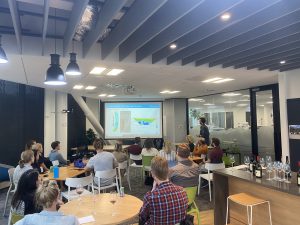 Managed aquifer recharge is a globally utilized technique to revitalize surface and groundwater resources. This approach leverages a variety of methods tailored to fit specific hydrogeological conditions and goals, including aquifer storage and recovery (injection/abstraction bores) and spreading techniques (infiltration ponds).
Managed aquifer recharge is a globally utilized technique to revitalize surface and groundwater resources. This approach leverages a variety of methods tailored to fit specific hydrogeological conditions and goals, including aquifer storage and recovery (injection/abstraction bores) and spreading techniques (infiltration ponds).
In the Canterbury region, efforts are underway to reduce nitrate levels in groundwater through recharge projects at various stages. Alongside this, near river recharge and stream/spring augmentation initiatives aim to boost baseflows and enhance the health of groundwater-fed ecosystems. However, the feasibility of implementing recharge sites across irrigation areas is dependent on water availability, regional planning, changes in land usage, and projected groundwater quality.
Infiltration ponds may play a crucial role in enhancing groundwater quality, quantity, and supporting ecosystems, but their effectiveness at the site level can be hindered by shallow groundwater levels, clogging, and the variability of less permeable alluvial deposits. Borehole investigations alone can miss the distribution of restrictive deposits, leading to underperforming recharge rates. By using geophysical techniques including resistivity tomography, electromagnetics, self-potential, and temperature sensing, primary infiltration pathways can be used to improve site selection and design. To mitigate the risk of microbial contamination, it is essential to conduct a thorough assessment of source water quality, transport modelling, and monitoring.




